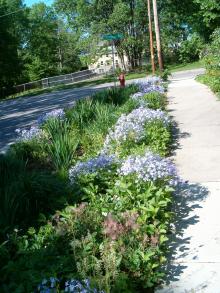






 It’s a Thursday afternoon, and it’s pouring rain. A woman stands in her front yard, shielded from the downpour by an umbrella, mesmerized by the runoff. Water rushes down the street and is funneled into a garden full of an eclectic collection of native Wisconsin plants, tall flowers, and grasses.
It’s a Thursday afternoon, and it’s pouring rain. A woman stands in her front yard, shielded from the downpour by an umbrella, mesmerized by the runoff. Water rushes down the street and is funneled into a garden full of an eclectic collection of native Wisconsin plants, tall flowers, and grasses.
This is just one of the Vilas Neighborhood’s seven rain gardens, soaking up rain runoff and naturally filtering it through the soil before it reaches Lake Wingra.
In a neighborhood filled with kids of all ages, the lake is a summertime hotspot for swimming, fishing, bird watching and more. But in the four year period between 2005 and 2009, the beaches along the lake were closed eight times as a result of high bacteria levels. In 2010, they were closed 40 times.
According to the Friends of Lake Wingra, low water quality in the lake is caused by a number of factors, including runoff from the city and surrounding neighborhoods, and increased goose feces.
When the beach was placed on the Environmental Protection Agency's (EPA) 303d list for impaired waters in 2007, the Friends of Lake Wingra had already begun remedying the problem through rain garden initiatives in key watershed districts like the Vilas neighborhood.
According to the EPA, impaired waters are bodies of waters where “existing pollution controls are not sufficient to attain or maintain applicable water quality standards.” Once a body of water is listed as such, a long term plan must be created to address the concern.
The rain gardens are only one part of the Friends of Lake Wingra’s three-pronged plan to improve the lake's water quality, which involves limiting goose populations, improving beachfront access, and protecting water quality in watershed districts.
The gardens are designed to keep storm runoff from carrying pollutants into the lake by providing a place for the water to soak into the soil before it reaches the lake. Specially designed drain systems help the gardens efficiently capture water runoff from streets and sidewalks.
Plants commonly found in rain gardens absorb large amounts of water, and can help catch and purify the water before it continues out of the garden and down into the watershed. The gardens are specially designed to prevent flooding of the surrounding areas. Drains direct the water to storm sewers if the water level in the garden gets too high.
Seven rain gardens were built in the Vilas Neighborhood along Adams Street in 2006. They were placed in residents' yards, between the sidewalk and the street. The original gardens were built by City Engineers in conjunction with a master gardener, with help from neighborhood residents.
The city of Madison offered to build 35 rain gardens in the Vilas Neighborhood in 2006, but only seven residents accepted the offer. At first, the idea of rain gardens was met with skepticism.
“People were concerned that [the rain gardens] were going to cause flooding in their basements,” Jon Standridge, Vilas Neighborhood Association President, says.
Jack Opel and his wife, one of the seven earlier adopters, says they agreed to the rain garden because they saw it as a sort of stewardship duty to the neighborhood and their home. They also wanted to help enhance the urban environment.
“It’s a great, useful way to use the land to fix a natural problem,” Opel says.
The Adams Street rain gardens are now a prominent feature of the neighborhood. Each individual garden has a placard describing the Rain Garden Pilot Project and the purpose of their unique combinations of long rooted native plants.
Since 2006, other neighborhood residents have come to see the beauty of the rain gardens, and their benefits to the neighborhood and the lake. There are now around 24 rain gardens in the neighborhood.
Kevin O’Brien finds the gardens both valuable and aesthetically pleasing.
“We weren’t offered rain gardens when our street was redone,” says O’Brien, “but I would have considered putting one in.”
O’Brien is not alone. To date, 498 rain gardens have been planted throughout Madison. The greatest number of them occur in neighborhoods surrounding Lake Wingra, according to the City of Madison’s 1,000 Rain Gardens website.
However, the use of rain gardens alone has not been enough to address the underlying water quality issues in the lake. In the summer of 2011, the Vilas Park Beach was closed seven times due to high bacteria levels.
And the Friends of Lake Wingra have not reached their goal of less than one bacteria-related Vilas Beach closing each summer. The group has started working with the Vilas Park Wildfowl Management Advisory Group, turning their focus to goose-related problems.
“We don’t have good data on the effect of rain gardens,” Jim Lorman, a member of the Friends of Lake Wingra and a professor in Edgewood College’s Sustainability Leadership Graduate Program, says. “They have to have a positive impact, but it’s not possible to say how much.”
Interested in helping clean up Lake Wingra or building a rain garden in your neighborhood? Visit the City of Madison’s website for more information.
|
|
|
Welcome to the Madison Commons, a website designed to provide news and information about all of Madison's neighborhoods and a crossroads for the discussion of community issues. The name comes from the idea of a village commons, a place for news, talk, debate, and some entertainment, too, that's open to everyone.
All rights reserved. Read more about the Madison Commons and its partners.

